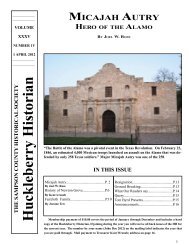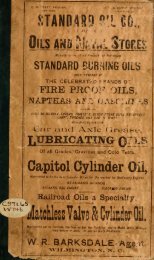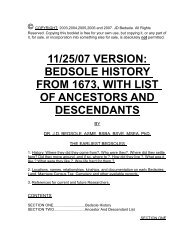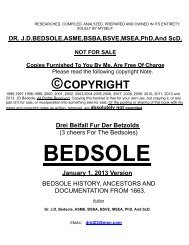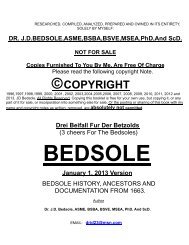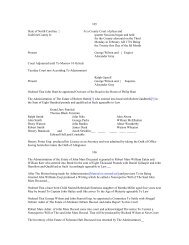Bedsole - NCGenWeb
Bedsole - NCGenWeb
Bedsole - NCGenWeb
You also want an ePaper? Increase the reach of your titles
YUMPU automatically turns print PDFs into web optimized ePapers that Google loves.
to Dobbs, Bertie, Edgecombe, Duplin, Bladen, Johnston, Sampson and finaly to Brunswick counties in NC,<br />
indicating a steady fan-shaped movement south and southwestward from Bath, now Beaufort, County.<br />
Ending at Brunswick County, near the state line with South Carolina, the fan-shaped movement is a familiar<br />
and predictive one when you are reviewing first settlements of new places. Reading about NC in general and<br />
Bath County in particular, I found that repeated Yellow Fever epidemics and fierce, barbaric, antagonistic and<br />
warlike indian tribes in and around NC and especially Bath back then, were also good reasons for these early<br />
arrivals to move and to move frequently.<br />
As you will see, documentation on Abraham, Elizabeth and Rose, ceased to exist after their arrival at Bath in<br />
May, 1701 and their arrival in Virginia in 1719-1726. Abraham and Rose's son William appeared on paper in<br />
Russell County, Virginia in the form of a handwritten land deed in 1719. Abraham and William both appeared<br />
the next time, in Spotsylvania County, Virginia in 1726, on a land record for 1,000 acres. Their last names<br />
were written on those land records as Bledsoe. The logical reason for that is that all record-keepers were<br />
English, and they wrote and spelled names they were familiar with, and since Bledsoe was in England as far<br />
back as the year 1061, they were very familiar with that spelling and freely assigned that spelling on anyone<br />
pronouncing their name even remotely like "Bledsoe" or "<strong>Bedsole</strong>". In Virginia, the trail became very<br />
muddled, with the appearance of several apparently bonified Bledsoe's, who became mixed with bonafide<br />
<strong>Bedsole</strong>s. Then, due to eglish Scribes, their last names were freely interchanged among them all.<br />
After that, the efforts to keep track and definition of the bonified <strong>Bedsole</strong>'s and the bonified Bledsoe's<br />
required quadrupling of time, efforts, research., study and analyses. All that required quadrupling again, after<br />
they all had sons whom they named after themselves, each other, uncles, parents and grandparents. It all<br />
became a royal mess, keeping track of who was whom. Through extensive use of the "Most Likely" research<br />
method, I did decide who was whom, as related to Abraham, at least to a point.<br />
. THE CONFUSION OF BEDSOLE AND BLEDSOE SURNAMES<br />
From the start, to current times, the North Carolina, Alabama, Tennessee, Georgia, Louisiana and Texas<br />
Census data repeatedly show Bledsoe's and <strong>Bedsole</strong>'s living among each other and when one moved, the<br />
others either went with them, or shortly afterwards, to the same place. That indicates to me that most, or at<br />
least many, <strong>Bedsole</strong>s and Bledsoes were either related or were freely using each others last name(s), or<br />
both. Of course, the spelling of names was always left up to the discretion, knowledge and ability of the<br />
Scribe at the time. If someone told the Scribe their last name was <strong>Bedsole</strong>, theres no doubt in my mind that<br />
the Scribe, being English, decided many times that they were actually Bledsoe's and not <strong>Bedsole</strong>'s, and<br />
spelled it as Bledsoe. A very major problem caused by all that uncertainty, was the inability to determine with<br />
any degree of certainty in most cases, if the "<strong>Bedsole</strong>" being researched was really a <strong>Bedsole</strong> or Bledsoe.<br />
And that is something which one must frequently decide without much or any, additional information.<br />
So for example, when a "John <strong>Bedsole</strong>" is listed on the 1790 Census' for Wake, Cumberland and Anson<br />
counties. It is likely that one of those Johns was the one born about 1730 and the other is the one born in<br />
1753. Or one or more Johns moved during the Census counts or, that third John is either the same guy<br />
PAGE NINE<br />
counted twice, or there was a John Jr. or Sr. in one or more, of those counties. It is also possible that they<br />
counted John Bledsoe in one and John <strong>Bedsole</strong> in the other, misspelling <strong>Bedsole</strong> or Bledsoe, or both. After<br />
all, how would Census Takers determine the various county boundaries, as they roamed the country side ?<br />
From studying all this and everything else I've come across, it makes me think that the early, and<br />
consequently many current, <strong>Bedsole</strong>s and Bledsoes are intermixed to the point of impossibility in defining<br />
them, with any degree of certainty, beyond ones best guess and, some <strong>Bedsole</strong>s assumed the Bledsoe



